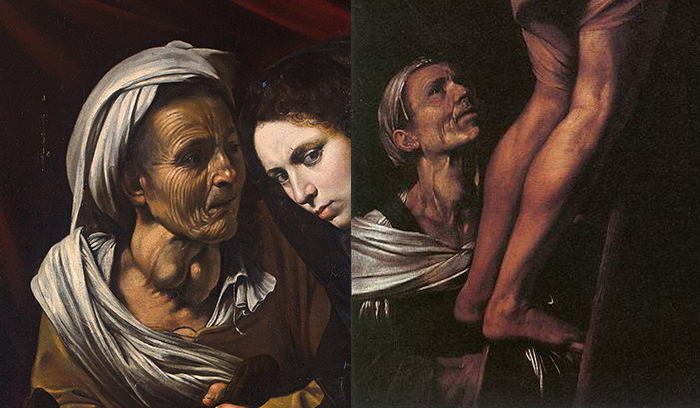
A
work some have attributed to Michelangelo Merisi, aka Caravaggio,
“Judith beheading Holofernes” (ca 1604–05), 144 x 173 cm (image courtesy
Eric Turquin) (click to enlarge)
The possible Caravaggio is currently on view in the Paris office of Old Master painting dealer Eric Turquin who, along with auctioneer Marc Labarde, has been working to authenticate the work since it was first found by a family in Toulouse in April 2014. It is being offered for sale to the French state for €120 million (~$135 million), and culture minister Audrey Azoulay has designated it a national treasure, which means it is barred from leaving the country for 30 months.

Caravaggio, “Judith Beheading Holofernes” (1598–99) (Galleria Nazionale d’Arte Antica, Rome, via Wikimedia Commons) (click to enlarge)
Indeed, contemporaneous documents confirm that Caravaggio is known to have painted a second version of the scene in 1604 or 1605 and is believed to have brought the picture with him when he fled Rome for Naples, where it is known to have been as early as 1607. The second “Judith Beheading Holofernes” was owned owned by the Franco-Flemish art dealer and painter Louis Finson, and a copy of it that he painted is in the collection of the Intesa Sanpaolo bank and on view at the Palazzo Zevallos in Naples. However, the location of Caravaggio’s second “Judith Beheading Holofernes” has been a mystery for centuries.

Details
of the possible Caravaggio painting “Judith Beheading Holofernes” (ca
1605–06, left) and the confirmed Caravaggio “The Crucifixion of St.
Andrew” (ca 1607, right, via Wikimedia Commons) that feature the same model
But if this indeed a real Caravaggio, how did it end up in an attic in Toulouse? “The home’s owners are descendants of an officer in Napoleon’s army,” Turquin told Le Figaro. “Perhaps it is through him that the painting made its way into the family’s possession.”
While Sébastien Allard, the director of France’s national painting collection, pores over a report by the Center for Research and Restoration of the French Museums to attempt to determine the possible Caravaggio’s authenticity and whether or not it should be acquired, Le Figaro has put it to a public vote. As of this writing, 69% of responders think France should buy the painting.

Δεν υπάρχουν σχόλια:
Δημοσίευση σχολίου